Before you begin
- Eat meals at a table. Ensure the chair and table are at a correct height for the child. Place a box or low step under the child’s feet if necessary.
- Sitting on a cushion can be unstable and make the child feel insecure.
- Consider a higher chair or stool with a foot rest. This one is from Ikea

- A Stokke Tripp Trapp chair, or Breezi Chair have an adjustable seat and foot plate which is easily altered as your child grows. They are more expensive but for a younger child they can be a good investment.

- Ensure there are minimal distractions e.g. turn off radios, TV.
- Sit and/or eat with the child to model correct cutlery skills. NB how do you hold cutlery and cut food?
- A right-handed person holds the fork in the right hand, a left-handed person the fork in he left.

- Choice of cutlery is important. Younger children will need junior size cutlery available from supermarkets/ good cookshops/ Ikea/ Amazon and other on-line suppliers.


- Older children would benefit from using small adult size cutlery with a good size handle.
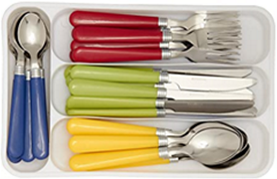
- Specialist larger handled cutlery is available. Kura Care cutlery has an ergonomic handle giving an improved grip and stability. Adult size is available in grey nad white. The coloured sets are toddler/ pre-schooler size. Available from many on-line suppliers, and some Disability Equipment shops.
Adult size Toddler size
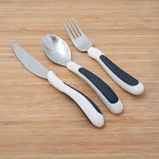
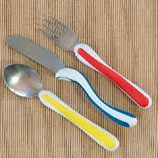
Activities to develop cutlery skills
- Ensure the child can stab the food with the fork pushing the fork fully into the food.
- Ensure the child knows how to cut with the knife using a to and fro sawing action. Many children tear and pull.
- Practise just suing the knife to get the cutting action. This can be with playdough or foods such as banana, cucumber, melon strips, picnic cocktail sausages
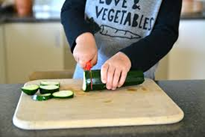
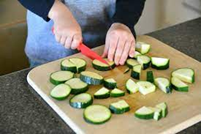
- Practise cutting food using playdough moulded into different shapes i.e. balls, sausages, burgers.
- Practise using a banana, marshmallow flumps, milky way.
- Place your hands over child’s (physical prompting) so that they can feel the correct position and movement; then let them try. Gradually reduce the amount of physical prompting as the child becomes more successful.
- Ensure the child knows where to position the fork to secure the food and where to cut with the knife. This is best taught using long sausage shapes of Playdough (or similar shape food i.e. sausage, banana, fish finger).
- For a right-handed person cut from left to right so that the cut portion can stay on the fork and go straight to the mouth.
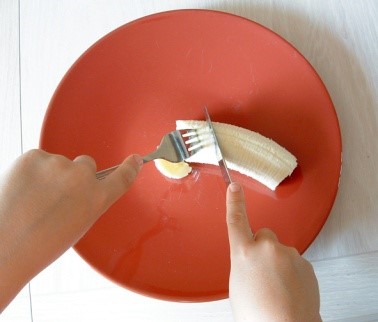
For a left-handed person cut from right to left so that the cut portion can stay on the fork and go straight to the mouth.
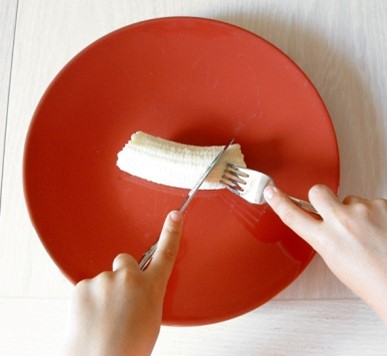
General Advice
Check if the plate is slipping on the table, this makes cutting food tricky. Use a non-slip mat. Dycem mat is a heavy weight non slip mat and will last many years.
The size Mat width: 250mm (10") Mat depth: 180mm (7.5") works well for a placemat at the table.
- www.dycem-ns.com
- www.healthcarepro.co.uk
- www.completecareshop.co.uk
- www.livingmadeeasy.org.uk
- www.amazon.co.uk
Consider choice of food at mealtime if practising cutlery skills. Don’t choose all foods that need cutting.
Whist practising at the mealtime cut up some of the food for the child so they can eat and then be more inclined to practise after a few mouthfuls of food.
Practise at snack time and for fun outside of a mealtime. Strips of fruit, softer vegetables such as courgettes, mushrooms, mini sausages, marshmallow flumps, milky way bars and fingers of fudge are good items to try.
